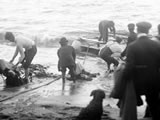What happened that day?
See historic events for any day of the year by entering the date below. Why not try your birthday?
Kiwi of the Week
Today in History

1909 SS Penguin wrecked in Cook Strait
The voyage began promisingly. On the evening of 12 February 1909 the Union Company's passenger steamer Penguin left Picton for Wellington in fine weather. The ship was small (749 tons) and old (launched in 1864), but had been rebuilt, and Captain Francis Naylor knew the route thoroughly.
By the time the Penguin entered the open waters of Cook Strait, however, it was dark and the weather had closed in, blacking out every landmark. Unable to see the Pencarrow light, Captain Naylor set a course to take him clear of danger. He later made another course change, intending to ride out the storm until daylight, but then the ship struck heavily - with a noise like ‘the rending of a gigantic piece of calico', a seaman recalled. The Penguin began sinking in heavy seas off a rugged, isolated stretch of coast.
The practice of ‘women and children first’ prevailed but this proved disastrous as the lifeboats they were placed in quickly capsized in the rough seas. None of the children and only one of the women, Ada Hannam, survived. Hannam was declared a heroine in the days that followed, particularly for her efforts assisting in the rescue of the youngest survivor, teenager Ellis Matthews. But this would have been of small consolation to the then pregnant Hannam; she had lost her husband and four children in the wreck. Only 30 of the 102 people who had set out from Picton that summer evening lived to tell the tale, 72 perished, making it New Zealand's worst 20th century maritime disaster (some contemporary accounts put the number of people on board at 105, with 75 deceased).
All but 13 of the bodies were eventually recovered. Most were transported via the salvage tug Terawhiti to Miramar wharf and then to the drill hall in Buckle Street for identification. A public funeral was then held in Wellington on 16 February. The half-day holiday declared for the event saw thousands line the street as ‘a cortège of cabs and lorries’ left the drill hall, thousands more met the cortège at Karori Cemetery. The deaths of the four McGuire children were among those that ‘touched the people of Wellington’. They had been placed in St Andrews Presbyterian Orphanage, Nelson after their mother's death in 1906 but were on their way to be reunited with their father, who had recently remarried.
Although some said the Penguin had struck a drifting wreck, it is widely believed that it struck Thoms Rock off Cape Terawhiti, after being carried off course by an exceptionally strong flood tide. The inquiry blamed Captain Naylor and suspended his certificate for 12 months. But it was also unanimous that once disaster struck Naylor ‘did everything in his power to prevent loss of life’.
Further information: Bruce Collins, The wreck of the Penguin, Wellington, Steele Roberts Limited, 2000.
Image: men pulling bodies and wreckage ashore after the disaster (Wreck of the Penguin - Te Ara)














